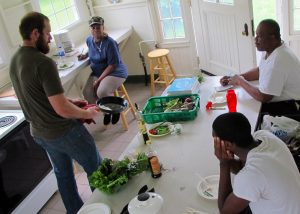 It’s one thing to learn how to grow fresh produce. It’s quite another to know what to do with it once harvested—especially if you’ve never tasted or cooked with it before.
It’s one thing to learn how to grow fresh produce. It’s quite another to know what to do with it once harvested—especially if you’ve never tasted or cooked with it before.
So the new Farm to Food Desert program at the Case Western Reserve University farm in Hunting Valley began recently with an introduction to a variety of lesser-known vegetables and how to prepare them.
Although cautioned about its bitter taste, Iman Glanton, one of five Cleveland residents selected to work in the program, took a bite of kale, scrunched his face and put the leafy green back on the table.
Glanton and other program participants “enjoyed” similar introductions to Swiss chard, rosemary, sage and a host of more common vegetables grown on the farm—tomatoes, cucumbers, green onions and radishes.
The tastings were accompanied by cooking tips from Bainbridge Township chef Richard Coop, a graduate of the Academy of Culinary Education in California.
Farm to Food Desert is aimed at helping Cleveland residents in areas lacking places to buy fresh produce and healthy and affordable food—often referred to as “food deserts.”
The idea is to teach residents gardening and cooking skills to harvest and prepare what’s in short supply in their neighborhoods.
The five participants, who applied for and were accepted to the program, tend the university’s vegetable gardens with students and volunteers. The harvested food supplies Case Western Reserve’s student dining halls. Some also goes to the Cleveland Metroparks Zoo to feed the animals.
The five Farm to Food Desert workers are paid minimum wage, receive bus transportation to the farm from CWRU’s University Circle campus and take home a bag of fresh produce each week.
But a bag of unfamiliar vegetables does them no good. So Chris Bond, the farm’s horticulturalist, arranged for Coop’s hands-on instruction.
Coop advised the program participants to first smell the produce and taste it while it’s raw. And then experiment.
As part of the introduction, Coop offered basic tips on caramelizing and sautéing the produce to make a savory mix of cooked vegetables. He showed them how to create a tasty salad of raw greens splashed with homemade balsamic vinegar and oil dressing. He demonstrated how to use vinegars or fresh lemon juice to remove some of the natural bitterness.
As the participants took notes, Coop explained how mushrooms should be broken apart in similar-size pieces so they all finish cooking at the same time. Between the chopping and stirring at the stove, they had questions about nutrition, exercising and the best type of food for different body types.
They got to taste plump oyster mushrooms, harvested from the farm’s new mushroom cellar, caramelizing in butter with the savory rosemary, sage and kale adding a kick of flavor.
The roughly 400-acre University Farm consists of Squire Valleevue and Valley Ridge Farms on Fairmount Boulevard.

